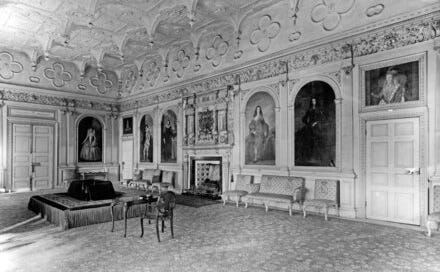I’ve talked quite a bit in previous posts about how country house interiors get thinned out, for example at Tyntesfield.
Here it was partly done by later owners, partly by the National Trust, but both united in their belief that High Victorian design should not suffer to exist in any way.
This was also what motivated James Lees Milne when he cleared out Stourhead in the 1950s.
Death to the aspidistra1.
But there’s a further reason for why this editing happened, which is a collective idea of what a stately home was meant to look like. The ideal goes back to well before the Trust started collecting houses, and it comes from the magazine, Country Life.
Objectively, Country Life is hilarious. You can read old copies online, and they are like a window into the collective mind of the aristocracy: dogs, shooting, hunting, the Royal Family, new aristocratic debutantes available on the marriage market and horses. And of course, houses too.
This the magazine did very thoroughly, covering a huge number of stately homes, mansions and country houses over the last 120 years, and photographing them both inside and out. Sometimes this is the only record of how a house used to look - but it is a very particular kind of archive, because Country Life had opinions.
It started off being interested in Mansions of Ye Olden Times, but a bit later on, the magazine led the revival of interest in classical houses which began in the 1920s. Highlighting these meant editing out the Victorian clutter with which many - perhaps most - aristocrats still lived.
Articles from this period, suggested that “to an unwary eye… it was possible to live in a large country house with no more furniture than a pair of high-backed Charles II chairs and a suit of armour”. When the magazine visited Audley End, the daughter of the house said that it was worse than burglars2.
This approach has had a couple of side effects. To start with, this new love of the Georgian, presented in this sparse and thinned out way, affected how people thought stately homes ought to look. This included their owners, who were, after all, the readers of the magazine - Lord Lothian removed all the Victorian changes to the Long Gallery at Blickling after a visit from Country Life. On top of this, it influenced people like James Lees Milne. Which is why Stourhead ended up looking the way it did.
The other is around restoration. I used this picture of Whistlejacket in situ when I posted about Wentworth Woodhouse the other day.
I can’t prove it, but I strongly suspect that this is from Country Life. But if this is the only record there is of what it looked like, then how will we ever know how it was really lived in? And were Wentworth Woodhouse to be restored, whose version of the house would we be creating? Quite possibly not the one which was first designed.
All stately homes are stage sets. From the moment they were built, these are buildings designed for displaying a lifestyle, a particular version of taste, a vast quantity of conspicuous consumption. I’m fine with that, it’s what they are here to do.
Where I have a problem is when people start pretending that these things - the taste, the way things look, the attitudes that made them - are eternal. That’s nonsense. Every single thing that we are looking at is not just a product of a place and time, it has also been chosen and arranged, many times in its history.
To me, that’s great - it makes everything more interesting, whether that’s the Whistlejacket room or an aspidistra. But to do this, we have to accept that nothing we are looking at is inevitable. What we are looking at, in every single grand house that we visit, is a curated experience: a display which someone - whether the owner or an institution - has selected and chosen. It is not innate, it is not just a piece of historical evidence and it is definitely not the only way that this house has looked over time.
This sounds like common sense, but many people seem unwilling to acknowledge that it’s true. Why this should be could be an entire post of its own, or possibly even a book. I’d better get on with it.
There is a whole book on how we cannot cope with High Victorian Design which needs to be written and at very least I need to devote a blog post to it. Will add that to the list.
These descriptions are from Michael Hall’s book, From the Archives of Country Life, which is a surprisingly entertaining account.









